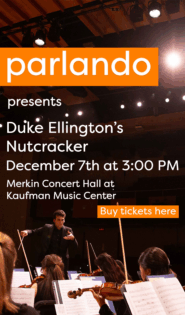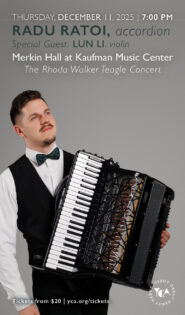Mäkelä, Orchestre de Paris conjure a spectacular “Firebird,” visceral “Rite”

A hundred and eleven years ago, a ballet audience in Paris experienced “the shock of the new” as never before, when the primitive rhythms and dissonances of Igor Stravinsky’s The Rite of Spring touched off the most famous riot in music history.
Three years before that, many of those same Parisians had been happy to let the exotic Russian sights and sounds of The Firebird give them, if not a shock, at least a frisson of the new.
On the evidence of Saturday’s Carnegie Hall concert by the Orchestre de Paris conducted by Klaus Mäkelä, today’s Parisian musicians are at least as good as their predecessors at administering the shakes and shivers of these early Stravinsky masterpieces—and probably much better.
One was reminded in particular of French prowess in woodwind playing, a tradition dating back more than two centuries, and very much on display Saturday night. Stravinsky’s novel combinations of wind instruments, and ventures into the extremes of their ranges, had a lot to do with the far-out character of these works.
But it was the double basses that scored first on Saturday, starting The Firebird with a silky chromatic figure, super-pianissimo yet filling the room with a feeling of menace. Throughout the evening, that section’s deep foundation would power the hijinks above.
However, it seems that the finest string and woodwind playing in the world can’t make some sections of the complete Firebird ballet interesting as concert music, particularly early on in the ballet’s story. An active figure on the podium, Mäkelä conducted those parts as if the music were developing in some direction, when it was really just keeping time for dancers onstage. Not much of interest to listeners was lost in 1911 and 1945, when the composer trimmed those pages, leaving his indelible melodies and fantastical dances intact in concert suites that run half as long as the ballet.
But when the “good parts” came on Saturday, they were very good. Winds sparkled and fluttered in the Firebird’s dance, though not quite as light on their feet as the swaying and shimmying conductor. One sometimes had the feeling that Mäkelä was asking for a bit more vital expression than he was getting from his players, who were executing what Stravinsky called his “wastefully large” orchestrations—three harps, for goodness’ sake—more superbly than spontaneously.
Still, this was a Firebird you could take your 10-year-old to, and watch their eyes grow large. See the Firebird arrive in a mad flutter of strings! Thrill to the Infernal Dance of the evil Kashchei! Nap to the bassoon’s lullaby! Gasp as the Hymn of Thanksgiving swells to fill the world, and then gets bigger!
If, in The Firebird, one had the sensation the musicians were showing a spectacle to the audience, in The Rite of Spring they were clearly living it. From the bassoon’s iconic opening solo and tangle of archaic winds to the most final whomp! in music, the Rite is a concert piece to end all concert pieces, coming at you with one astonishing episode after another. Mäkelä and the players fed off each other’s energy to produce a performance that one hopes was as breathtaking for them to play as it was for the audience to hear.
Cannily gauging his effects, Mäkelä led a vigorous but not over-the-top “Augurs of Spring.” On what was a good night for bassoons, that instrument danced nimbly among the chugging, syncopated string chords. The grinding beat and lugubrious melody of “Spring Rounds” slowed the tempo but reduced none of the dramatic tension.
The ripping and trilling strings in the “Ritual of Abduction” were scary, and the slashing syncopations of the “Ritual of the Rival Tribes” sounded positively dangerous (the composer of West Side Story knew his Rite), its momentum driving straight into the frenetic “Dance of the Earth” that closed Part I.
Part II began in undulating mists, as violins sighed and double basses made the earth heave. Full-toned flutes flew up and floated over the “Mystic Circles of the Young Girls,” slowly dancing to violas and cellos, then to a bassoon. A mighty whack of the bass drum hurled the listener into the “Glorification of the Chosen One,” with its precedent-shattering barbaric stomps and whoops.
“Evocation of the Ancestors,” a violent fanfare with drum rolls, announced the “Ritual Action of the Ancestors,” an artfully built long crescendo over a rock-steady ticking beat. The sense of firm control in this passage persisted somehow into the final, frenetic “Sacrificial Dance,” even as conductor and players appeared possessed by its demonic energy.
The shattering end of the Rite brought the audience instantly to its feet—in recognition, one hoped, as much of musical history brought to life as of the achievement of these immensely accomplished visitors from abroad.
Carnegie Hall presents the Mahler Chamber Orchestra with Mitsuko Uchida, pianist and director, in works by Mozart and Widmann, 8 p.m. March 28. carnegiehall.org





Posted Mar 17, 2024 at 1:32 pm by John kelly
I completely agree with every word of this well-written review. Principal oboe in particular stood out as a magnificent occupant of that seat and the bassoon had a huskiness associated with French orchestras of old. The hushed section before the horn solo in the finale of the Firebird was a simply magical passage.
Makela was incredibly impressive and the orchestra applauded him (with foot stomping) after the Rite,refusing to stand at his urging at the third curtain call. A tremendous concert from the music director of the Concertgebouw (and possibly the Chicago Symphony….it would be a good choice).